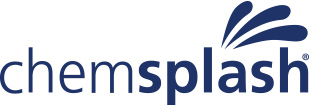Type 5/6 Disposable Coveralls: A Versatile Solution for Multiple Industries
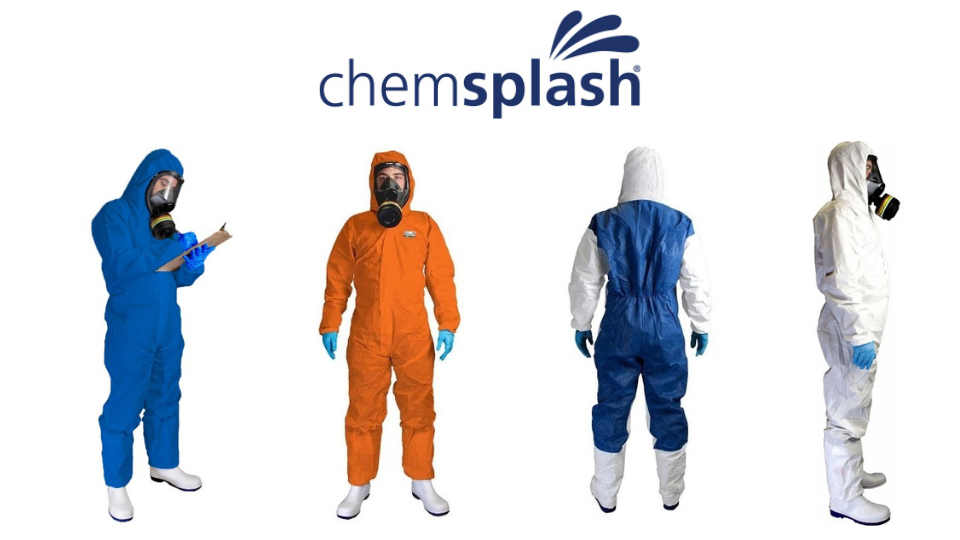
In today's fast-paced and demanding work environments, safety is paramount. Industries such as healthcare, manufacturing, construction, and more require reliable personal protective equipment (PPE) to ensure the well-being of their workers. One such essential piece of PPE is Type 5/6 disposable coveralls. In this article, we will explore the versatility of Type 5/6 disposable coveralls and their applications across various industries.
TABLE OF CONTENTS
- Understanding Type 5/6 Disposable Coveralls
- Type 5/6 Disposable Coveralls Applications per Industry
- Benefits of Type 5/6 Disposable Coveralls
- Choosing the Right Type 5/6 Disposable Coverall
Understanding Type 5/6 Disposable Coveralls
Type 5/6 disposable coveralls are designed to protect individuals from a wide range of hazards, including solid particulates and liquid splashes. They are crafted from specialized materials that offer excellent barrier properties and resistance to penetration. These coveralls provide workers with peace of mind, knowing they are shielded from potential dangers.
Definition and Purpose
Type 5/6 disposable coveralls are specifically designed to meet the European Norm (EN) standards for protective clothing. These standards ensure that the coveralls provide reliable and consistent protection in hazardous environments where exposure to solid particulates and light liquid splashes is a concern.
Type 5 coveralls focus on safeguarding the wearer against solid particulates such as dust, fibres, and powders. These coveralls act as a physical barrier, preventing these particles from reaching the skin and reducing the risk of contamination or respiratory issues. This is particularly crucial in industries where workers may encounter airborne particles that can pose health risks.
On the other hand, Type 6 coveralls offer additional defence against light liquid splashes. This includes protection against water-based chemicals and liquids that may present a hazard in various work environments. The coveralls are designed to prevent these liquids from penetrating the fabric and coming into contact with the wearer's skin.
The combination of Type 5 and Type 6 features in Type 5/6 disposable coveralls provides a versatile and comprehensive solution for a wide range of industries and applications. These coveralls are made from either SMS fabric or microporous laminated fabric. SMS fabric, which stands for Spunbond-Meltblown-Spunbond, is a tri-layered material that offers excellent barrier properties while maintaining breathability. Microporous laminated fabric, on the other hand, incorporates a breathable film or coating that provides a protective barrier against particulates and light liquid splashes.
By utilizing Type 5/6 coveralls, workers in industries such as healthcare, manufacturing, construction, and chemical sectors can confidently work in hazardous environments, knowing that they have reliable protection against both solid particulates and light liquid splashes. These coveralls offer peace of mind, ensuring the safety and well-being of individuals exposed to potential hazards in their daily work activities.
| Explore more: Chemsplash® Eka 55 Type 5B/6B Coverall |
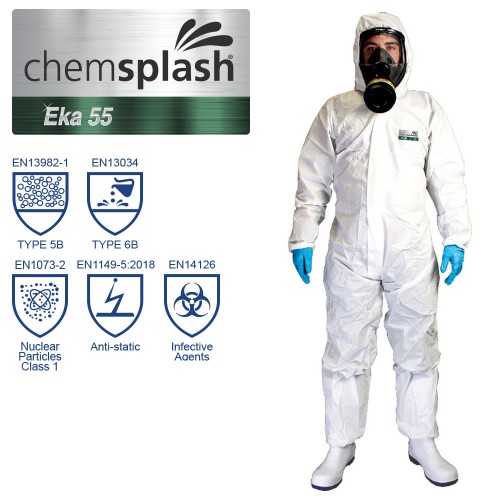 |
Key Features and Specifications
Type 5/6 disposable coveralls boast several key features and specifications that contribute to their effectiveness in providing protection. When choosing these coveralls, it is important to consider the following features:
SMS Fabric or Microporous Laminated Fabric
Type 5/6 coveralls are commonly constructed using SMS fabric or microporous laminated fabric. SMS fabric consists of three layers: spunbond, meltblown, and spunbond. This material offers a balanced combination of barrier properties and breathability, ensuring comfort during extended wear. Microporous laminated fabric incorporates a breathable film or coating that provides protection against solid particulates and light liquid splashes.
Elasticated Cuffs and Ankles
Type 5/6 coveralls feature elasticated cuffs and ankles. These elasticized components create a secure and snug fit, minimizing the risk of particles or liquids entering the coverall through openings.
Adhesive Zip Flap
The coveralls are designed with an adhesive flap that covers the zip closure. This additional protective layer helps to prevent the entry of contaminants through the zipper area, ensuring a more robust barrier.
Taped and Bound Seams
Many Type 5/6 coveralls incorporate taped and bound seams. These sealed seams provide enhanced protection by preventing the penetration of particles and liquids through the stitching, reducing the risk of exposure
Antistatic property
Some Type 5/6 coveralls are equipped with an antistatic feature. This characteristic helps to dissipate static electricity, reducing the possibility of sparks in environments where flammable substances are present. It adds an extra layer of safety in such work settings.
Elasticated Hood
Comprehensive head protection is ensured with the inclusion of an elasticated hood in Type 5/6 coveralls. The elasticized hood offers a secure and comfortable fit around the face, minimizing the chance of particulates or liquids entering the coverall through the head area.
Non-Linting property
Type 5/6 coveralls are designed to be non-linting, meaning they do not shed fibres or particles. This feature prevents contamination of the work environment and helps maintain the integrity of sensitive processes in industries such as pharmaceuticals, electronics, or cleanrooms.
Sterile and Irradiated
Certain Type 5/6 coveralls are available in sterile and irradiated versions. These coveralls undergo sterilization processes, such as gamma irradiation, to achieve a higher level of sterility. They are commonly used in cleanroom environments where maintaining a sterile atmosphere is crucial.
These notable features and specifications make Type 5/6 disposable coveralls a reliable choice for individuals working in hazardous environments. The combination of effective barrier protection, comfortable fit, and additional features ensures that workers are adequately safeguarded against solid particulates and light liquid splashes.
| Explore more: Chemsplash® Xtreme 50 SMS Type 5/6 Coverall |
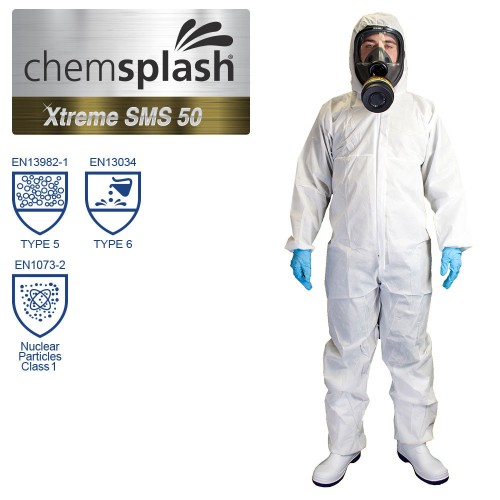 |
Type 5/6 Disposable Coveralls Applications per Industry
Healthcare
In the healthcare industry, Type 5/6 disposable coveralls play a vital role in protecting healthcare workers from various hazards. These coveralls are commonly used in hospitals, clinics, and laboratories, where there is a risk of exposure to infectious materials, biological hazards, and chemical splashes. Healthcare professionals rely on Type 5/6 coveralls to maintain a safe and hygienic environment while providing patient care.
In hospitals and clinics, healthcare workers come into contact with patients who may have contagious illnesses. Type 5/6 disposable coveralls act as a barrier against airborne particles and bodily fluids, reducing the risk of cross-contamination between patients and healthcare providers. These coveralls help prevent the transmission of infectious diseases and maintain the overall cleanliness and safety of healthcare settings.
Laboratories also benefit from the use of Type 5/6 disposable coveralls. In research laboratories, pharmaceutical companies, and diagnostic laboratories, workers handle potentially hazardous materials such as chemicals, biological samples, and pharmaceutical compounds. Type 5/6 coveralls provide a protective barrier against accidental spills, splashes, and exposure to harmful substances, ensuring the safety and well-being of laboratory personnel.
Manufacturing and Engineering
The manufacturing and engineering sectors involve processes that can generate dust, particles, and chemical splashes. Type 5/6 disposable coveralls are widely employed in these industries to protect workers from harmful substances and maintain their safety during operations such as machining, welding, painting, and handling hazardous materials. The durability and protective features of Type 5/6 coveralls make them an essential part of personal protective equipment (PPE) in manufacturing and engineering environments.
In manufacturing facilities, workers may be exposed to airborne particles, such as metal shavings, dust, or fibres, which can cause respiratory issues or skin irritation. Type 5/6 disposable coveralls act as a barrier, preventing these particles from coming into contact with the skin and reducing the risk of inhalation. Additionally, when handling chemicals or working with processes that involve splashes or spills, Type 5/6 coveralls offer protection against potential chemical hazards.
Engineering industries, including construction, automotive, and aerospace sectors, also rely on Type 5/6 disposable coveralls. These coveralls protect workers from the hazards associated with construction sites, where dust, debris, and chemical substances are present. They provide a comfortable and secure fit, allowing workers to move freely while ensuring their safety and minimizing the risk of contamination or injury.
Construction and Demolition
Construction and demolition sites pose various hazards, including exposure to dust, debris, and chemicals. Type 5/6 disposable coveralls are crucial for workers in these industries to safeguard against particulates, paint splashes, cement dust, and other potential contaminants. The breathable yet protective nature of Type 5/6 coveralls ensures that workers can perform their tasks comfortably and safely on construction sites.
Construction workers often handle materials such as concrete, insulation, or fibreglass, which can release harmful particles into the air. Type 5/6 disposable coveralls act as a barrier, preventing these particles from settling on the skin or being inhaled. Moreover, when using paints, solvents, or adhesives that may cause splashes or spills, Type 5/6 coveralls provide effective protection against chemical contact and minimize the risk of skin irritation or injury.
Demolition sites also require the use of Type 5/6 disposable coveralls due to the presence of dust, debris, and potentially hazardous materials. These coveralls ensure that workers are shielded from harmful substances released during demolition activities, such as asbestos fibres, lead particles, or other toxic materials. By wearing Type 5/6 coveralls, workers can minimize their exposure to these hazards and maintain their safety throughout the demolition process.
Chemical and Pharmaceutical Industries
In chemical and pharmaceutical industries, where workers handle potentially hazardous substances, Type 5/6 disposable coveralls provide critical protection. These coveralls are essential for workers involved in chemical handling, pharmaceutical manufacturing, and laboratory operations. The high-level protection against particulates and light liquid splashes offered by Type 5/6 coveralls helps prevent chemical contamination and ensures the safety of workers involved in these industries.
Chemical plants and manufacturing facilities often deal with corrosive or toxic chemicals that can cause skin irritation, burns, or respiratory issues. Type 5/6 disposable coveralls act as a barrier against these substances, minimizing the risk of direct contact and offering protection from splashes or accidental spills. Additionally, the antistatic feature found in some Type 5/6 coveralls helps dissipate static electricity, reducing the risk of sparks and explosions in environments where flammable substances are present.
Pharmaceutical companies and laboratories also require the use of Type 5/6 disposable coveralls to maintain a sterile and controlled environment. These coveralls help prevent cross-contamination during the manufacturing and handling of pharmaceutical products, ensuring product integrity and patient safety. Sterile and irradiated versions of Type 5/6 coveralls are particularly suitable for cleanrooms and controlled environments, where sterility is crucial to avoid compromising sensitive processes or contaminating products.
The wide range of applications across these industries demonstrates the versatility and effectiveness of Type 5/6 disposable coveralls in providing reliable protection against a variety of hazards. These coveralls are designed to meet the specific needs of each industry, ensuring the safety and well-being of workers in diverse work environments.
| Explore more: Chemsplash® Delta 67 Type 5B/6B Coverall |
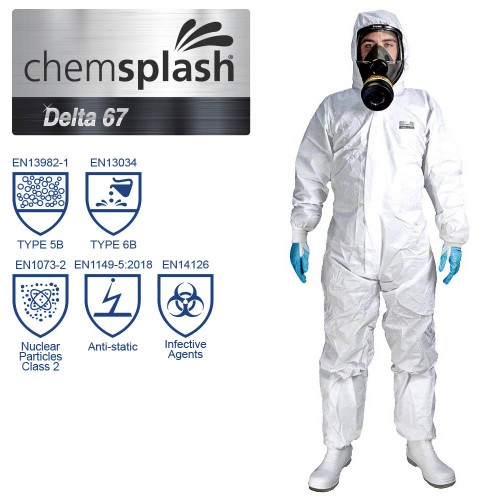 |
Benefits of Type 5/6 Disposable Coveralls
Type 5/6 disposable coveralls offer numerous benefits to workers in various industries. These coveralls provide reliable protection, ensuring the safety and well-being of individuals working in hazardous environments. The following are some key benefits of using Type 5/6 disposable coveralls:
Protection Against Chemical Hazards
One of the primary benefits of Type 5/6 disposable coveralls is their ability to provide effective protection against a wide range of chemical hazards. The barrier properties of the SMS fabric or microporous laminated fabric act as a shield against solid particulates and light liquid splashes, including various chemicals and substances encountered in different industries. Whether workers are handling corrosive chemicals, toxic substances, or potentially hazardous materials, Type 5/6 coveralls offer a reliable defence, significantly reducing the risk of chemical exposure and related health complications.
Contamination Control
Type 5/6 disposable coveralls play a crucial role in contamination control. These coveralls prevent particulates and liquids from entering or exiting the garment, minimizing the spread of contaminants. In industries where maintaining a sterile or controlled environment is essential, such as healthcare, pharmaceuticals, and cleanroom facilities, Type 5/6 coveralls are indispensable. By wearing these coveralls, workers contribute to maintaining cleanliness, preventing cross-contamination, and upholding stringent hygiene standards. They act as a physical barrier, reducing the risk of contamination from external sources and protecting sensitive processes or products.
Comfort and Breathability
Despite their high level of protection, Type 5/6 disposable coveralls are designed with comfort and breathability in mind. The SMS fabric used in many coveralls offers excellent breathability, allowing air and moisture vapour to pass through while maintaining a protective barrier. This helps to regulate body temperature and reduce discomfort caused by heat buildup during extended wear. The elasticated cuffs, ankles, and hood provide a secure and ergonomic fit, ensuring freedom of movement and comfort throughout the workday. Workers can perform their tasks without hindrance, promoting productivity and reducing fatigue associated with restrictive or uncomfortable clothing.
Easy Disposal and Hygiene
Type 5/6 disposable coveralls offer the advantage of easy disposal, promoting hygiene and preventing the spread of contaminants. After use, the coveralls can be safely discarded, eliminating the need for laundering or decontamination processes. This reduces the risk of cross-contamination during the handling and cleaning of reusable garments. Workers can simply remove and dispose of the coveralls, ensuring a hygienic environment and minimizing the potential for contact with hazardous substances or contaminants.
Versatility and Suitability for Various Tasks
Type 5/6 disposable coveralls are highly versatile and suitable for a wide range of tasks in different industries. Whether it's working in a healthcare setting, handling chemicals, engaging in construction activities, or participating in cleanroom operations, Type 5/6 coveralls provide the necessary protection. Their comprehensive defence against solid particulates and light liquid splashes makes them ideal for diverse applications. With these coveralls, workers can transition seamlessly between different tasks and environments, knowing they are adequately protected.
In addition to their protective benefits, Type 5/6 disposable coveralls are cost-effective solutions. They eliminate the need for repeated washing and decontamination, as they are designed for single use. This not only saves time and effort but also ensures consistent protection without the risk of wear and tear associated with reusable garments.
Overall, Type 5/6 disposable coveralls offer a combination of reliable protection, contamination control, and comfort. They are versatile and adaptable to various industries, making them an essential part of personal protective equipment (PPE) for workers operating in hazardous environments. By choosing Type 5/6 coveralls, individuals can confidently carry out their tasks, knowing that they are well-protected and can focus on their work without compromising safety or comfort.
| Explore more: Chemsplash® Cool 67 Type 5/6 Coverall |
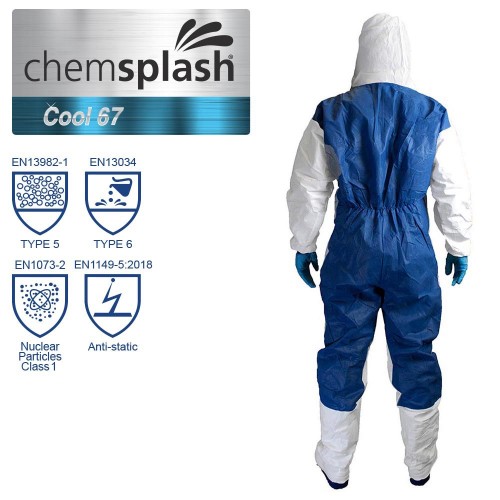 |
Choosing the Right Type 5/6 Disposable Coverall
Material Selection
When selecting the right Type 5/6 disposable coveralls, one crucial factor to consider is the material used in their construction. The two commonly used materials are SMS fabric (Spunbond-Meltblown-Spunbond) and microporous laminated fabric.
SMS fabric is renowned for its exceptional breathability, allowing air and moisture vapour to pass through while maintaining a protective barrier against solid particulates and light liquid splashes.
On the other hand, microporous laminated fabric features a breathable film or coating that provides a robust shield against particulates and liquid splashes.
To make an informed choice, it's essential to assess the specific requirements of the work environment. Consider factors such as the level of protection needed, the duration of wear, and the potential exposure to hazardous substances. SMS fabric, with its superior breathability, may be more suitable for tasks requiring extended periods of wear or activities in warmer environments. Conversely, microporous laminated fabric might be preferred in situations where additional protection against liquid splashes is a primary concern. By understanding the characteristics and benefits of each material, you can select the Type 5/6 coveralls that best align with your specific work environment and requirements.
Sizing and Fit
Optimal sizing and fit are paramount when choosing Type 5/6 disposable coveralls. Ill-fitting coveralls not only compromise the overall effectiveness of the protective garment but can also impede the wearer's mobility and comfort. To ensure a proper fit, it is essential to follow the manufacturer's sizing guidelines and consider the individual's body measurements. This may include factors such as height, weight, chest circumference, and waist size.
Choosing the right size of coveralls involves finding a balance between comfort and security. The coveralls should allow for freedom of movement and flexibility while providing a snug fit that minimizes the potential for gaps or exposed areas. A well-fitting garment ensures that the wearer can perform tasks without restriction and maintains the integrity of the protective barrier.
Additionally, some manufacturers may offer a range of sizes to accommodate different body types, allowing for a more customized fit.
Certification and Compliance
When selecting Type 5/6 disposable coveralls, it is crucial to prioritize certifications and compliance with relevant safety standards. The European Norm (EN) standards play a significant role in ensuring the quality and effectiveness of these protective garments.
Here are a few key EN standards associated with Type 5/6 disposable coveralls:
EN 13982-1: This standard specifies the requirements for coveralls that provide protection against hazardous solid particulates, including Type 5 coveralls. It sets criteria for the fabric's resistance to penetration by solid particles and provides guidelines for the design, performance, and marking of the coveralls.
EN 13034: The standard relates to coveralls that offer protection against liquid chemicals, including Type 6 coveralls. It defines the requirements for the fabric's resistance to penetration by liquid chemicals, as well as other properties such as strength, durability, and design.
EN 1149: This standard focuses on electrostatic properties and specifies requirements for protective clothing with antistatic properties, including Type 5/6 coveralls. It sets criteria for the surface resistance and charge decay of the fabric to minimize the risk of sparks and discharge in environments where flammable substances are present.
EN 14126: The standard addresses protective clothing against infectious agents and specifies requirements for coveralls that offer protection against biological hazards. It includes testing methods for determining the resistance of the fabric and seams to penetration by biological agents.
By choosing Type 5/6 disposable coveralls that carry the CE (Conformité Européene) marking, you can ensure compliance with the necessary European standards for protective clothing. The CE marking indicates that the coveralls have undergone rigorous testing and meet the required performance and safety criteria. It provides assurance that the coveralls have been manufactured in accordance with recognized industry standards, undergo regular quality control checks, and provide the specified level of protection against solid particulates and light liquid splashes.
Prioritizing certification and compliance not only ensures the quality and reliability of the coveralls but also contributes to the overall safety of the wearer in hazardous environments. By selecting coveralls that comply with the relevant EN standards, you can have confidence in the protective capabilities of the Type 5/6 disposable coveralls and enhance workplace safety.
| Explore more: Chemsplash® Type 5/6 Coveralls |
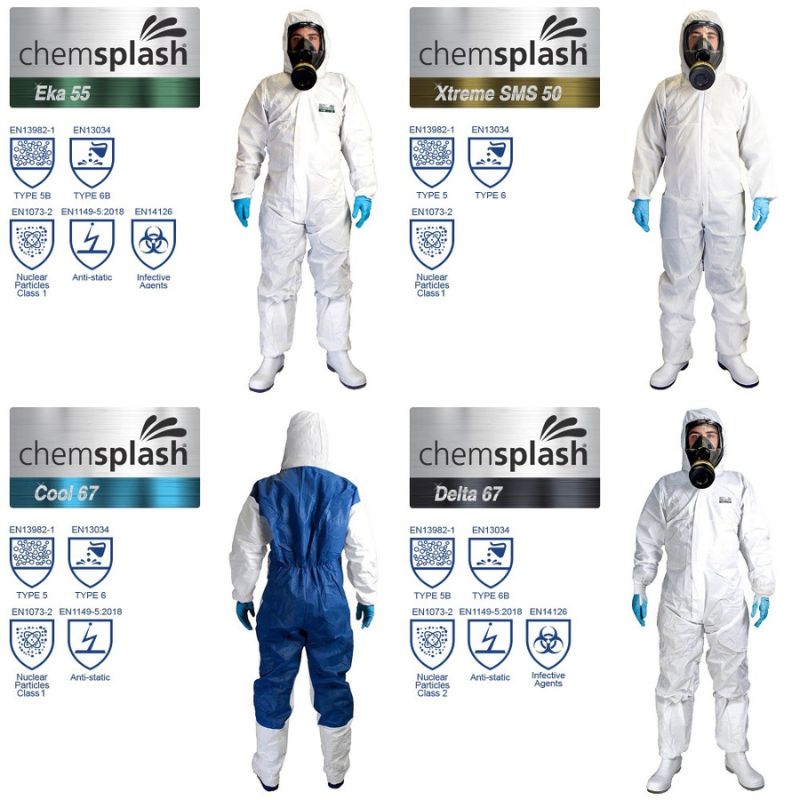 |
Conclusion
Type 5/6 disposable coveralls are essential personal protective equipment (PPE) that play a vital role in various industries such as healthcare, manufacturing, construction, and chemicals. Designed to meet European safety standards, these coveralls provide reliable protection against solid particulates and light liquid splashes. They are crafted from SMS fabric or microporous laminated fabric, striking a balance between barrier properties and breathability.
Notable features of Type 5/6 coveralls include elasticated cuffs and ankles, adhesive zip flaps, taped and bound seams, an elasticated hood, and non-linting properties. In healthcare settings, these coveralls shield against infectious materials, while in manufacturing, they guard against dust and chemical splashes. On construction sites, they offer protection from dust and debris, and in chemical and pharmaceutical industries, they minimize the risk of chemical exposure.
The advantages of Type 5/6 disposable coveralls include defence against chemical hazards, effective contamination control, comfort and breathability for extended wear, easy disposal, and versatility across various work environments. When selecting the appropriate coveralls, it is crucial to consider the material used and the specific requirements of the work environment.
To ensure the safety and well-being of workers in hazardous environments, we strongly recommend exploring the comprehensive range of Type 5/6 Disposable Coveralls offered by Chemsplash. By choosing high-quality protective gear, you can prioritize worker safety and make informed decisions for your PPE needs.
| Get in touch - Contact Us! |
Your email address cannot be published. Required fields are marked*
